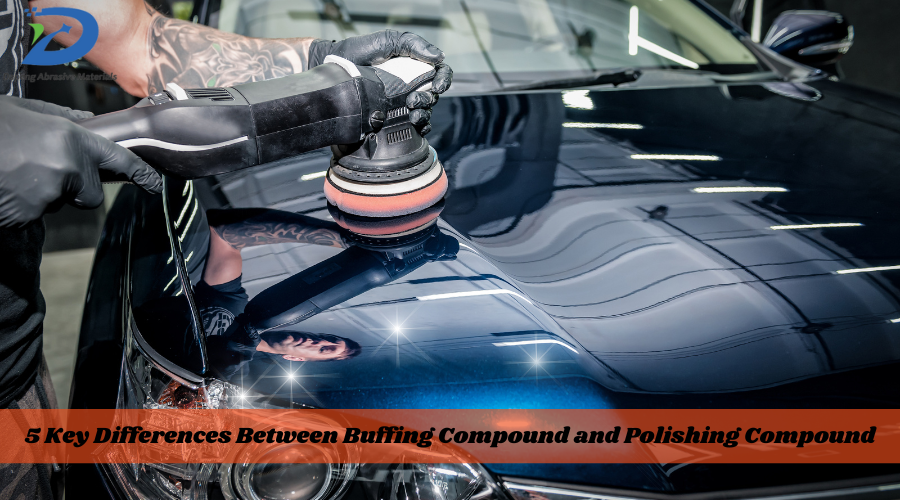



In car detailing, woodworking, metalworking, and other surface refinishing processes, the terms buffing compound and polishing compound often come up. While they may seem similar, these two compounds serve distinct purposes and are essential in achieving different levels of surface smoothness and shine. Understanding the difference between them can help you choose the right one for your project, whether you're working on a car, furniture, or metal objects. This guide will take you through the 5 key differences between buffing compound and polishing compound, offering insights on their composition, usage, and results.
The primary difference between buffing and polishing compounds lies in their purpose and function.
Buffing compounds are generally designed to remove imperfections, scratches, and oxidation from a surface. They are often the first step in surface preparation. Buffing compounds are typically more abrasive, which means they can smooth out rough surfaces and remove minor flaws. They are used when you need to prepare a surface for the next finishing stages.
Polishing compounds, on the other hand, are meant for the final step in the surface finishing process. They are less abrasive and are designed to refine the surface to a high shine. Polishing compounds help enhance the gloss of a surface and provide a smooth, reflective finish.
In essence, buffing is the rougher process of smoothing out a surface, while polishing is the fine-tuning process of making the surface shine.
Another major difference between these two compounds is their abrasiveness.
Buffing compounds are more aggressive and coarse in nature. They are formulated with larger abrasive particles to help remove material from the surface, which makes them ideal for tasks that involve eliminating deep scratches or heavy oxidation. Buffing is also used to remove old paint layers or rough spots.
Polishing compounds, on the other hand, contain finer abrasive particles. Their goal is not to remove material but to smooth out the microscopic imperfections left behind by the buffing process. Polishing compounds are less likely to scratch the surface, and they’re used when a high-gloss finish is desired.
In simple terms, buffing compounds are like sandpaper, helping to rough up the surface, while polishing compounds are like fine wax, giving the surface a smooth, shiny finish.
How you apply these compounds plays a significant role in achieving the desired outcome. Each type of compound requires a different technique to get the best results.
Buffing compounds are typically applied using a buffing wheel or a rotary tool with a soft cloth or foam pad. The application of a buffing compound is often done at higher speeds to help with the abrasion process. During buffing, you’ll notice that the compound creates a certain amount of heat and friction, which is essential for smoothing out the surface.
Polishing compounds, on the other hand, are generally applied with a polishing pad at a lower speed. The goal is not to create friction but to work the compound into the surface gently, ensuring that the surface is evenly polished without causing any damage.
When applying these compounds, it’s important to follow the manufacturer’s recommendations for both application speed and pressure. Applying too much pressure while using a buffing compound can lead to surface damage, while using a polishing compound with too little pressure might not yield the desired finish.
The choice of compound depends largely on the material you are working with, as certain compounds work better on different surfaces.
Buffing compounds are more commonly used for harder surfaces or materials that require more aggressive treatment, such as metal, automotive paint, and stone. They are particularly effective on materials that have significant imperfections, oxidation, or dullness.
Polishing compounds, being gentler, are often used on softer surfaces or materials that require fine-tuning, such as wood, plastics, and glass. They’re ideal for creating a smooth, glossy finish on delicate surfaces without causing damage.
When choosing between buffing and polishing compounds, you must consider the type of material being treated to ensure that you use the appropriate level of abrasiveness for that material.
The final key difference between buffing and polishing compounds is the end result and finish that each compound leaves behind.
Buffing compounds are designed to prepare the surface by removing imperfections, leaving a surface that is smoother but may not have a high shine. The surface will likely have a matte or satin appearance after buffing, which can look dull and uneven until polished.
Polishing compounds, on the other hand, are specifically formulated to enhance the surface’s appearance and create a glossy, mirror-like finish. After polishing, the surface will appear more refined, sleek, and highly reflective, which is often the final look desired for vehicles, metals, or other fine materials.
In conclusion, buffing compounds are designed to improve the surface by removing imperfections, while polishing compounds focus on creating the desired high-gloss finish.
Understanding the differences between buffing and polishing compounds is crucial when it comes to achieving professional-level results in surface refinishing. Whether you are restoring a car’s paint job, refinishing a wooden piece of furniture, or working with metals, knowing which compound to use at the right stage can make all the difference.
Buffing compounds are ideal for the initial surface preparation stage, where imperfections and scratches need to be removed. They are more abrasive and create a smoother but often matte surface. Polishing compounds, on the other hand, should be used as the final step to achieve a glossy, reflective finish that enhances the surface’s visual appeal.
By selecting the right compound based on the material, desired finish, and surface condition, you can ensure your project looks flawless and professionally done. So, whether you’re buffing out the rough edges or polishing to perfection, remember to choose the appropriate compound to achieve the best possible result.
If you're serious about achieving a professional finish on metalwork, wood, or other materials, then a sisa...
READ FULLPolishing wheels are applied in numerous industries as the final step ...
READ FULLIn metal polishing applications, choosing the right buffing wheel is e...
READ FULL